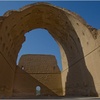Disclaimer
This entry contains information known to us from a variety of sources but may not include all the information currently available. Please be in touch if you notice any inadvertent mistakes in our presentation or have additional knowledge or sources to share. Thank you.
Archive
Mahoza near Baghdad, Iraq
In the early 6th century, Mahoza was the center of a independent Jewish kingdom, ruled by the exilarch Mar Zutra II (c. 496-520). Already a center of trade and learning in Babylon, the city had been destroyed in 363 AD and rebuilt a few years later.1 It remained part of the independent Jewish state for seven years, until Mar Zutra's defeat and death at the hands of the Persians. Mahoza is now part of the present-day city of al-Mada'in, not far from Baghdad. Also close by is Salman Pak, the burial place of Shallum, the brother of a former exilarch. Shallum, who was viewed as a hero by the Muslims and Jews of Babylon, defeated the Persians in the early 7th century and established a capital at Mahoza.2
Description
Mahoza The ancient city of Mahoza was located on the bank of the Nahar Malka, a canal connecting the Tigris and Euphrates rivers. It was a suburb of Be-Ardashir, a city dating from roughly 230 CE on the left bank of the Tigris.3 Several trading routes, both caravans and river trade, passed through Mahoza. Many of Mahoza’s Jews were successful traders or farmers; by the mid-300s, the majority of the city’s population was Jewish.4 Starting in the late 200s, the city became a center of study; around that time, Joseph ben Hama founded an academy that would grow to great success under the leadership of his son Raba.5 Emperor Julian destroyed Mahoza in 363 when he invaded Babylon, but after his death the city was rebuilt.6 In the early 500s, it became the center of an independent Jewish state led by the exilarch Mar Zutra II.
Mar Zutra II the center of an independent Jewish state led by the exilarch Mar Zutra II. Mar Zutra II (c. 496-520) was the son of Huna, a previous exilarch killed by the Persians.7 According to tradition, Mar Zutra II was the sole survivor of the House of David. In 512, his grandfather Hanina had him installed as the official exilarch, at the age of fifteen.8 The new exilarch led four hundred soldiers against the Persians and won several victories, allowing him to establish an independent Jewish state based in Mahoza. Seven years later, the Persians finally defeated him; he and Hanina were captured and eventually executed.9
Exilarchs The title exilarch first appeared in late antiquity as an office responsible for administering communal affairs among Babylonian Jews.10 It eventually developed into a hereditary title—justified by a claim of descent from King David—and one of the principal offices of centralized Jewish authority. Babylonian exilarchs were often wealthy, as well as being frequent attendees at the Sasanian royal court; many were criticized for being too close to Persian rulers, as well as their lax religious observance.11
Sources
[1] Beer, Moshe. Encyclopaedia Judaica. "Mahoza." Detroit: Macmillan Reference USA, 2007. Accessed August 4, 2014. http://go.galegroup.com/ps/i.do?id=GALE%7CCX2587513033&v=2.1&u=mlin_m_wellcol&it=r&p=GVRL&sw=w&asid=2ea41df345288184f92d75190df9e080
[2] The Committee for Historical Research in Islam and Judaism. "The Conquest of Persia and Shallum's Return." 2012. Accessed August 5, 2014. http://www.alsadiqin.org/en/index.php?title=The_Conquest_of_Persia_and_Shallum%27s_Return
[3] Beer. "Mahoza."
[4] Ibid.
[5] "Mahoza." Jewish Encyclopedia. 2011. Accessed August 5, 2014. http://www.jewishencyclopedia.com/articles/10292-mahoza
[6] Beer. "Mahoza."
[7] "Zutra, Mar." Encyclopaedia Judaica. Detroit: Macmillan Reference USA, 2007. Accessed August 4, 2014. http://go.galegroup.com/ps/i.do?id=GALE%7CCX2587521673&v=2.1&u=mlin_m_wellcol&it=r&p=GVRL&sw=w&asid=9c496ef5205f850027a41a72d0eca8ff
[8] Ibid.
[9] Ibid.
[10] Franklin, Arnold. Encyclopedia of Jews in the Islamic World. "Exilarch and Exilarchate." Brill Online, 2014. Accessed August 5, 2014. http://0-referenceworks.brillonline.com.luna.wellesley.edu/entries/encyclopedia-of-jews-in-the-islamic-world/exilarch-and-exilarchate-COM_0007510
[11] Ibid.



